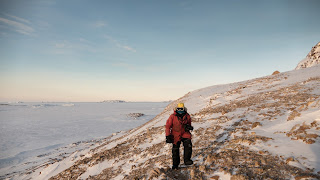I don't have a map for you this time, sorry. I'll try and wrangle one for you with Day 3.
Day 2 began with coffee and fruit-toast. People adapt amazingly quickly to new levels of "normal", and down here, in the field, a slab of buttery fruit-toast is the absolute pinnacle, complete perfection. There is nothing better. We couldn't bask in luxury for long though, there was more progress to be made, so after breakfast we broke camp and took off quick-smart.
Prior to this expedition my record for furthest traveled west (in the South...) was Proclamation Point (more on Proc Point in Day 4), on the west side of the Taylor Glacier. In fact, none of we six expo's had ever been past that point before, so we were heading into truly unknown territory today.
Day 2 began with coffee and fruit-toast. People adapt amazingly quickly to new levels of "normal", and down here, in the field, a slab of buttery fruit-toast is the absolute pinnacle, complete perfection. There is nothing better. We couldn't bask in luxury for long though, there was more progress to be made, so after breakfast we broke camp and took off quick-smart.
Prior to this expedition my record for furthest traveled west (in the South...) was Proclamation Point (more on Proc Point in Day 4), on the west side of the Taylor Glacier. In fact, none of we six expo's had ever been past that point before, so we were heading into truly unknown territory today.
Which turned out to be hours of soul-destroying, back-breaking, 8km/hr sastrugi. Hurrah.
Evidently the sea ice is normally smoothest closest to the plateau edge. Unfortunately, navigating around protruding glaciers means heading waaaaaay out towards the sea edge, and the provided GPS travel routes are placed a bit off shore to protect us from the risk of calving ice. So: sastrugi.
This time round our patience lasted two, maybe two and a half hours... after which we kicked it straight back inland and found the sweet sweeeeeet smooth ice to bring our average speed back up to 30km/hr. Sastrugi really is genuinely unbearable in a Hagglund.
In hour four of the drive we made a short stop at Tilley Nunatak (another helo fuel depot - apparently they're everywhere) to check on the drums (yep, still there) and enjoy the wind.
In hour four of the drive we made a short stop at Tilley Nunatak (another helo fuel depot - apparently they're everywhere) to check on the drums (yep, still there) and enjoy the wind.
 |
| Auto-focus on blowing snow. |
From Tilley it was a steady trip along the coast into the Stillwell Hills and past the Dovers Glacier. This is where things got really interesting for me; the geography out there is completely different from the Antarctica that I'm used to. Around Mawson the Antarctic plateau dominates, there are distant mountain ranges, and a few small islands. In comparison the Stillwell Hills are a large group of taller hills right on the plateau coast, with islands of a similar size all around.
The landscape blew my mind.
But there was still a ways to go before we could settle down. We paused at one point to try out the Hagglunds HF transmitters, were met with abject failure, and retreated to good ol' sat phones. ANARE expeditions are a precision machine.
After the whole HF fiasco was thrown in the "too hard" basket we finished the last six kilometers to the Ledingham's Depot site, and were rewarded with the most spacious field accommodation any of us have ever been too. Good god was it comfortable.
Of course, we were here to get work done! So work we did. There was some very minor maintenance to be done by electrician, although things were generally in good working order. The plumber set about replacing and pressure testing gas regulators, and the chippy started stripping and resealing the joins in the fiberglass structure. His was the biggest job of the trip so everyone not too attached jumped in to assist... I spent a lot of time scraping silicone on this trip.
We also spent some time pitching a polar pyramid. I hate the polar pyramid (although I've never had to use one in anger). Pyramid shaped tent, very sturdy, reasonably warm. Getting in and out of it is like being born. We brought two of them with us in case we needed extra sleeping space on the trip, but there was also a pyramid left at Ledingham's that was the designated "toilet tent". Doing your business in Antarctica can be an inglorious business, but on a five day trip it is a bit of a necessity. Yes, it gets cold.
 |
| Polar pyramid right of screen. |
We finished the day off with another gourmet (frozen) meal sent by Kim and the nightly sched, after which I set about building a nest. The hut may have only had three beds but it also had plenty of space, and there was a camp bed available so I stashed it under a trestle table and built it up with bear rugs and sleeping bags.
I slept wonderfully.
Accommodation at Ledingham's Depot: melon has three beds and two on the floor, JB sleeps outside.
Misc photos:





















































